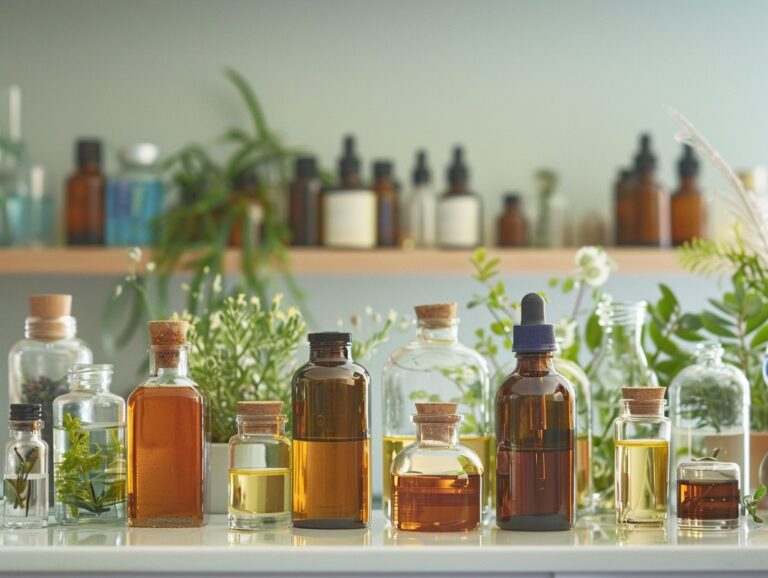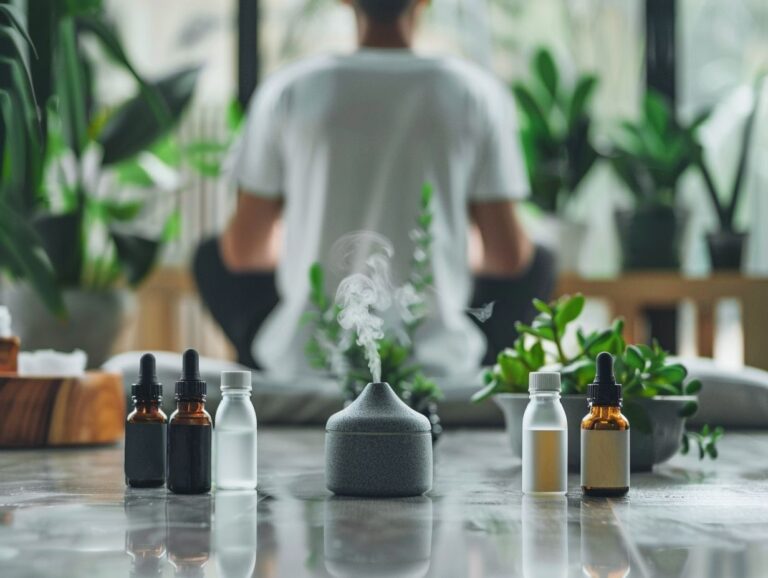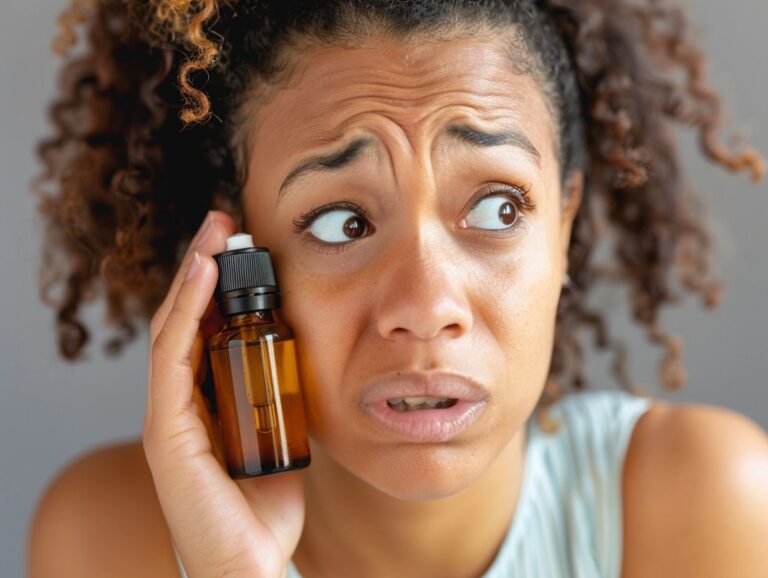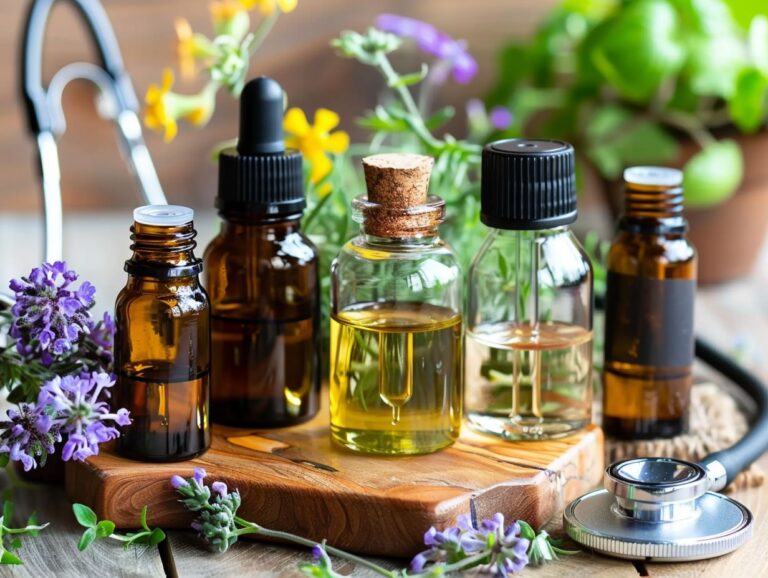Are Essential Oils Vocs
Essential oils have been gaining popularity for their various benefits, but are they the same as VOCs?
We will explore what VOCs are and how essential oils differ from them.
We will also discuss the benefits and risks of using essential oils, including the potential for allergic reactions and interactions with medications.
We will cover how essential oils are used, safety precautions to take, any regulations in place, and common essential oils like lavender, peppermint, and tea tree. Let’s dive in!
Key Takeaways:
What Are Essential Oils?
Essential oils are natural products extracted from aromatic plants through methods like distillation or biosynthesis. They contain aromatic components that are highly concentrated and responsible for their distinct fragrance.
These aromatic components, commonly known as terpenes, are synthesized in the plants through complex biochemical pathways. Terpenes are the primary constituents of essential oils and give each oil its unique scent and therapeutic properties. For example, limonene is a terpene found in citrus essential oils, offering uplifting and invigorating effects. In aromatherapy, essential oils are used for their diverse benefits – from promoting relaxation and reducing stress to boosting mental clarity and improving sleep quality.
Are Essential Oils VOCs?
The question of whether essential oils are VOCs is a complex one. Essential oils do contain volatile organic compounds (VOCs) due to the presence of various chemicals like terpenes. Analyzing them through techniques like GC/MS reveals the concentration of these compounds.
Terpenes are one of the key contributors to the volatile nature of essential oils. These organic compounds are responsible for the distinct aromas and flavors found in different types of essential oils. Plus terpenes, essential oils also contain alcohols, esters, and phenols, all of which contribute to their volatile properties.
Gas chromatography/mass spectrometry (GC/MS) is a crucial analytical technique used to identify and quantify the specific oils present in essential oils. This process involves separating the individual components of the oil and determining their chemical makeup.
Volatile organic compounds in essential oils can have significant effects on our health and wellbeing. When inhaled or applied topically, these compounds interact with our bodies through processes such as aromatherapy or skin absorption.
What Are VOCs?
Volatile Organic Compounds (VOCs) are organic chemicals that vaporize at normal room temperatures. They are often emitted from various sources, including aromatic plants, as by-products of biosynthetic processes involving precursor molecules.
VOCs play a significant role in atmospheric chemistry as they contribute to the formation of ground-level ozone and secondary organic aerosols, both of which have environmental and health implications.
Aromatic plants, such as eucalyptus, lavender, and jasmine, release volatile compounds like terpenoids and phenylpropanoids. The biosynthesis of VOCs in these plants involves complex pathways, starting from basic building blocks like acetyl-CoA and shikimate. Enzymatic reactions catalyze these pathways, leading to the creation of diverse volatile organic compounds that give each plant its distinct scent and chemical fingerprint.
How Are Essential Oils Different From VOCs?
While essential oils contain VOCs, they differ from typical VOCs due to their specific health benefits and aromatic components. Essential oils are purposefully extracted for their therapeutic properties, unlike general VOCs found in the environment.
Essential oils are highly valued for their natural healing properties and have been used for centuries in traditional medicine practices. Each essential oil carries its own unique set of benefits for physical, emotional, and mental well-being.
One of the key distinctions is that essential oils are derived from plant materials through processes like steam distillation or cold pressing, preserving the concentrated essence of the plant. This results in a potent and pure form of the oil, free from synthetic additives or harmful chemicals. To learn more about essential oils and herbs, visit essential oils herbs.
The aromatic components in essential oils are responsible for their therapeutic effects and play a significant role in influencing mood, reducing stress, and promoting relaxation.
What Are the Benefits of Essential Oils?
Essential oils offer a wide range of benefits, including promoting physical and mental health through aromatherapy. Their biosynthetic molecules interact with the body to provide therapeutic effects, with each oil containing unique components.
These natural oils have been used for centuries due to their healing properties. Aromatherapy enthusiasts appreciate how different oils can impact mood, reduce stress levels, and even alleviate pain. For example, lavender oil is known for its calming effects, while eucalyptus oil is popular for respiratory relief. The intricate blends of bioactive compounds found in essential oils offer a holistic approach to well-being, targeting both physical and emotional aspects of health.
What Are the Risks of Essential Oils?

Essential oils are highly concentrated plant extracts that can trigger allergic responses in sensitive individuals. Symptoms of allergic reactions may include skin irritation, respiratory issues, or even anaphylaxis in severe cases. Certain essential oils have active compounds that can interfere with medications, affecting their efficacy or causing adverse effects.
To minimize risks, it is essential for users to perform a patch test before using a new essential oil topically and dilute them properly. Consulting with a healthcare professional, especially if you are taking medications, is important to avoid any potential interactions. Being informed and cautious can help individuals enjoy the benefits of essential oils safely.
How Are Essential Oils Used?
The usage of essential oils is diverse, with aromatherapy being a common application.
These oils extracted from aromatic plants through processes like distillation play a crucial role in providing therapeutic benefits.
Aromatherapy, one of the key uses of essential oils, involves inhaling or applying these concentrated plant extracts to gain their healing properties.
Distillation, the primary method of extracting essential oils, allows for the separation of volatile compounds from plant material through evaporation and condensation processes.
Aromatic plants, such as lavender, eucalyptus, and peppermint, are cultivated specifically for their essential oils, which are highly valued for their medicinal and aromatic qualities.
What Is Aromatherapy?
Aromatherapy is a holistic healing treatment that uses essential oils to promote physical and mental well-being. The fragrance and components of these oils play a key role in the therapeutic effects of aromatherapy.
In aromatherapy, different essential oils are carefully selected and blended to create specific scents that trigger responses in the brain, promoting relaxation, reducing stress, and improving overall mood. Essential oils possess unique properties that can help alleviate various physical and emotional ailments, such as lavender for calming effects, peppermint for invigoration, and eucalyptus for respiratory support. Through inhalation or topical application, these oils interact with the limbic system, influencing emotions, heart rate, blood pressure, and stress levels.
What Are the Different Ways to Use Essential Oils?
Essential oils can be used in various ways, including aromatherapy, topical application, and inhalation. These diverse methods cater to different preferences and allow for customized use based on concentration and health goals.
Aromatherapy is a popular way to enjoy the benefits of essential oils by inhaling the aromatic scents. The scents can help relax the mind, improve mood, reduce stress, and promote better sleep. Topical application involves diluting essential oils in carrier oils and applying them directly to the skin. This method is beneficial for targeting specific areas for relief from pain, inflammation, or skin conditions.
Inhalation, on the other hand, involves diffusing essential oils into the air, allowing their molecules to be inhaled. This method can help with respiratory issues, improve focus, and purify the air. The concentration of oils used in each method can greatly influence their effectiveness and potential side effects. It’s essential to understand the proper dilution ratios and usage guidelines to maximize the benefits of essential oils.
What Are the Safety Precautions When Using Essential Oils?
Safety precautions are essential when using essential oils to prevent adverse reactions and ensure effective outcomes. Individuals should be cautious about allergies, proper dilution, and suitable application methods for different purposes.
When using essential oils, it is crucial to consider potential allergies that individuals may have to certain oils, which can lead to skin irritation, respiratory issues, or other adverse effects. Proper dilution ratios play a vital role in ensuring that the oils are safely applied without causing skin sensitivities or other complications.
Understanding the correct application techniques for each oil type is key to maximizing their benefits. For example, some oils are best used topically, while others are more suitable for inhalation or diffusion. Ensuring that essential oils are stored properly in dark, glass containers away from direct sunlight and heat can also help maintain their potency and shelf life.
Are There Any Regulations on Essential Oils?
Regulations on essential oils vary across regions and aim to ensure product quality, safety, and consumer protection. Standards and guidelines are in place to govern the production, labeling, and distribution of essential oils.
These regulations are crucial for maintaining the integrity of the essential oil industry. They encompass a range of factors, such as the sourcing of raw materials, the manufacturing process, and the storage conditions. By adhering to these standards, companies can guarantee that their products meet certain quality benchmarks.
Consumer confidence is significantly impacted by these regulations. When customers see that essential oils comply with specific guidelines, they are more likely to trust the efficacy and safety of the products they are purchasing. This trust is fundamental in establishing long-term relationships between brands and consumers in the essential oil market.
What Are Some Common Essential Oils?

For example, lavender is known for its calming effects, making it ideal for aromatherapy to help reduce stress and promote relaxation.
Peppermint has invigorating properties that can aid in alleviating headaches and boosting energy levels.
Tea tree oil is valued for its antibacterial and antifungal properties, often used topically for acne treatment and wound care.
Eucalyptus is commonly used for respiratory support due to its refreshing scent and decongestant effects.
On the other hand, lemon oil is praised for its uplifting and cleansing properties, often found in cleaning products and air fresheners.
Lavender
Lavender essential oil is renowned for its calming properties and is often used for relaxation and stress relief. Its pleasant aroma promotes a sense of well-being and tranquility.
One of the key components of lavender essential oil is linalool, which is known for its soothing effects on the nervous system. When inhaled, this oil can help reduce anxiety and improve sleep quality, making it a popular choice for those looking to unwind after a long day.
In aromatherapy, lavender oil is commonly used in diffusers or added to bath water to create a calming atmosphere. Its antimicrobial properties also make it a versatile addition to skin care products, helping to soothe inflammation and irritation.
Peppermint
Peppermint essential oil is known for its refreshing aroma and is commonly used to aid digestion, boost energy levels, and enhance mental clarity. Its invigorating scent promotes alertness and focus.
Peppermint oil’s digestive benefits stem from its ability to relax the muscles of the gastrointestinal tract, aiding in smoother digestion and alleviating symptoms like bloating and indigestion. Additionally, peppermint oil is revered for its mental health benefits, as it has been found to reduce stress, anxiety, and fatigue. The energizing effects of this oil can help combat mental fatigue and improve cognitive function, making it a valuable tool for enhancing productivity.
Tea Tree
Tea tree essential oil is renowned for its antibacterial and antifungal properties, making it a popular choice for skincare applications. Its cleansing and purifying effects support healthy skin and hair.
These properties of tea tree oil not only help to combat acne and blemishes but also soothe skin irritations such as eczema or psoriasis. The oil’s natural astringent properties make it effective in controlling excess oil production, making it suitable for oily and combination skin types.
Tea tree oil is known for its anti-inflammatory properties, which can aid in reducing redness and swelling, leaving the skin looking more balanced and even-toned. Its ability to promote wound healing and prevent infections further enhances its benefits for skincare.
Eucalyptus
Eucalyptus essential oil is valued for its respiratory benefits, particularly in relieving congestion and promoting clear breathing. Its soothing properties make it a popular choice for aromatherapy during cold and flu seasons.
One of the main advantages of eucalyptus oil lies in its ability to act as a decongestant by helping to loosen mucus and phlegm in the respiratory tract, making it easier to expel. This natural remedy is also known for its ability to reduce inflammation and provide relief from respiratory conditions like bronchitis and sinusitis. The calming effects of eucalyptus oil can create a sense of relaxation and ease discomfort when breathing becomes labored or blocked. Through its dual action of clearing congestion and promoting a soothing environment, eucalyptus oil plays a valuable role in supporting respiratory health.
Lemon
Lemon essential oil is known for its invigorating and cleansing properties, offering a fresh and uplifting aroma. Its citrus scent promotes a sense of vitality and purification.
Whether used in aromatherapy diffusers or added to cleaning products, lemon oil can create an environment that feels energized and revitalized. The zesty fragrance helps to uplift mood and enhance mental clarity. Incorporating lemon oil into skincare routines can promote a glowing complexion due to its purifying qualities. It can be used in DIY household cleaners to eliminate odors and disinfect surfaces naturally. The versatility of lemon essential oil makes it a popular choice for those seeking a natural way to cleanse the air and uplift the atmosphere.
Conclusion

Essential oils offer a diverse range of benefits for physical and mental well-being, but they also come with risks that require caution. Understanding the properties and applications of essential oils is key to harnessing their therapeutic potential effectively.
Essential oils are renowned for their aromatherapy properties that can alleviate stress, improve sleep quality, and boost mood. Nevertheless, improper use or excessive ingestion of essential oils may lead to skin irritation, allergic reactions, or other adverse effects. To ensure safe usage, it’s crucial to dilute essential oils properly, conduct a patch test before application, and seek advice from a qualified aromatherapist or healthcare professional.
Pregnant women, young children, and pets require extra caution when using essential oils due to their potential to cause harm in these specific populations. The effects of essential oils can vary depending on individual sensitivities and health conditions, underscoring the importance of personalized and informed approaches to incorporating them into daily wellness routines.
Final Thoughts and Recommendations
Essential oils can be valuable additions to daily routines for various health and wellness benefits. It is essential to prioritize safety, quality, and proper usage guidelines when incorporating essential oils into personal care or therapeutic practices.
Regarding safety, always remember that essential oils are highly concentrated plant extracts and should never be ingested without proper guidance from a qualified aromatherapist or healthcare provider. Dilution is key in topical applications to prevent skin irritation. Quality is crucial, so opt for reputable brands that provide pure, natural essential oils without synthetic additives.
Following recommended usage guidelines, such as proper dilution ratios and duration of use, is paramount to avoid potential adverse reactions. It’s important to store essential oils in dark, glass bottles away from heat and sunlight to maintain their efficacy.
By being mindful of these safety measures, quality considerations, and adhering to usage recommendations, individuals can harness the full potential of essential oils for improving their overall well-being and quality of life.
Frequently Asked Questions
Are essential oils considered Volatile Organic Compounds (VOCs)?
No, essential oils are not considered VOCs. Although they can emit a strong scent, they are not classified as VOCs because they are not derived from petroleum or other synthetic sources.
Can essential oils be harmful to indoor air quality?
In large quantities, essential oils can contribute to poor indoor air quality. It is important to properly dilute and use essential oils in well-ventilated spaces to avoid potential respiratory irritation.
Do essential oils contribute to indoor air pollution?
No, essential oils do not contribute to indoor air pollution. Unlike VOCs, they do not release harmful chemicals into the air and are considered safe for use in cleaning and personal care products.
Are essential oils safe to use around pets and children?
Some essential oils can be toxic to pets and children, so it is important to research and properly use oils that are safe for them. Oils should also be stored out of reach to prevent accidental ingestion.
Do essential oils have any health benefits?
Many essential oils are believed to have potential health benefits, such as reducing stress and promoting relaxation. However, it is important to consult with a healthcare professional before using essential oils for medicinal purposes.
Do essential oils have an expiration date?
Essential oils do not expire, but they can lose their potency over time. It is best to use them within 1-2 years of purchase and store them in a cool, dark place to prolong their shelf life.








One Comment